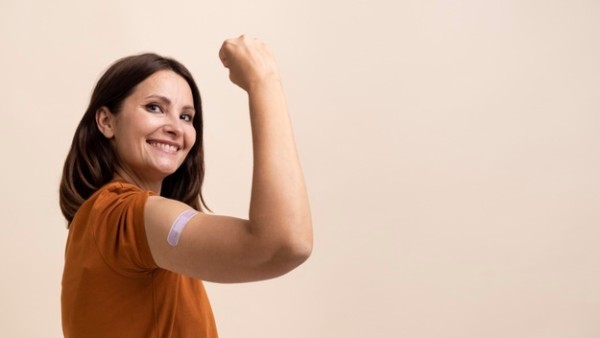Just In
- 57 min ago

- 4 hrs ago

- 7 hrs ago

- 9 hrs ago

Don't Miss
- Sports
 IPL 2024: 'Nothing To Do With Mental Health' - Glenn Maxwell Clarifies His Absence From RCB Playing 11
IPL 2024: 'Nothing To Do With Mental Health' - Glenn Maxwell Clarifies His Absence From RCB Playing 11 - News
 Karnataka Weather Alert: Will Bengaluru See Rain Before May?
Karnataka Weather Alert: Will Bengaluru See Rain Before May? - Finance
 Tata Motors To Utilize New $1 Billion TN Plant For Jaguar Land Rover Cars
Tata Motors To Utilize New $1 Billion TN Plant For Jaguar Land Rover Cars - Movies
 Very Parivarik Episode 5 OTT Release Date, Platform: Get Ready For Major Twist; Here's When & Where To Watch
Very Parivarik Episode 5 OTT Release Date, Platform: Get Ready For Major Twist; Here's When & Where To Watch - Technology
 AMD Revamps Business Computing with AI-Fueled Ryzen PRO 8000 Series Processors
AMD Revamps Business Computing with AI-Fueled Ryzen PRO 8000 Series Processors - Education
 RMLIMS Nursing Officer Recruitment 2024; Apply for 665 Vacancies, Know more
RMLIMS Nursing Officer Recruitment 2024; Apply for 665 Vacancies, Know more - Travel
Telangana's Waterfall: A Serene Escape Into Nature's Marvels
- Automobiles
 The Rezvani Retro RR1 Is A Modified Porsche 911 Done Right
The Rezvani Retro RR1 Is A Modified Porsche 911 Done Right
What Is 'Precaution Dose'? How Is It Different From A Booster Shot? Everything You Need To Know
From 10 January, India will begin administering the 'precaution dose' of the COVID vaccine to frontline workers and seniors with comorbidities. However, India's Omicron cases are also on the rise when the world is experiencing the fourth surge of the COVID-19 pandemic. As a result, states are taking restrictive measures.
In the speech given by Prime Minister Narendra Modi on December 25, the word 'precaution dose' rather than 'booster dose' caught everyone's attention. The third COVID-19 vaccine dose is called a booster dose or booster shot around the world.

What Is Precaution Dose?
A booster dose for strengthening immunity against emerging variants of SARS-CoV-2 has already been introduced in the world. Several countries have adopted this strategy. India, however, does not refer to it as a booster dose [1].
As of now, there is no exact definition of the term 'precaution dose'. Nevertheless, according to the recommendations given by the technical team on COVID vaccination, the third dose of the COVID vaccination should be a vaccine based on a different platform than the first two [2].
According to Indian law, people who are considered under the 'precaution dose' category have received their two doses of vaccine within the last five or six months. However, during the rise of Omicron, there was concern that their immunity may have weakened. Thus, the phrase' precaution dose' leaves open the possibility that the next dose may be a new vaccine rather than just the third shot.
Who Is Eligible For Precaution Dose?
As announced by Prime Minister Narendra Modi, those with illnesses eligible for the precaution dose will register on the CoWIN website once nine months have elapsed since their second vaccination [3].
Health ministry sources stated that, in contrast to what most advanced countries do, the crucial third dose would not be mixed with any other vaccines due to the rapid spread of Omicron in the country.
Will The Precaution Dose Be A Different Vaccine?
The precaution dose will be a third dose of the same vaccine a person has already taken, Covishield or Covaxin. One of the key elements will be the gap - the third dose will be administered 9-12 months following the second dose to health and frontline workers and senior citizens with co-morbid conditions, according to sources [4].
The issue of whether mixing vaccines or sticking to the same vaccine for the third dose offers greater protection has been debated extensively around the world. Specific data are not yet available for booster doses, but mixing the vaccines for the first and second shots has been shown to elicit a more robust immune response [5].
Will Precaution Dose Be Effective Against The New Omicron Variant?
During a short period of time, the number of cases of Omicron has rapidly increased, and scientists are trying to figure out why this has occurred. Despite the new variant being deemed mild so far, the high transmission rate has become a cause for concern.
The results of preliminary studies suggest that the two standard doses of the Coronavirus vaccine are ineffective against the new COVID-19 variant Omicron, raising further concerns [6]. Although more research is required, many experts believe that a third shot may provide greater protection against the new variant.

How To Register For Precaution Dose?
- It is mandatory to obtain a comorbidity certificate from a physician.
- When you register for a precaution dose, the app/portal will ask whether you have any comorbidities.
- If yes, you need to select yes for comorbidities.
- By clicking yes, your slot for the third dose will be reserved.
According to news agency ANI, Dr RS Sharma, executive director of the National Health Authority, senior citizens will be required to provide a comorbidity certificate before receiving the precaution dose [7].
The government will likely follow the same list of comorbidities used when the vaccination drive in India began in January of this year. According to reports, the interval between the second and third precaution doses is likely to be nine to twelve months.
Which Will Be The Vaccine For This Precaution Dose?
According to reports, the details will be finalised over the next few days in consultation with the experts. According to most health experts, the third or precaution dose should differ from the first two doses. However, the government has not yet announced any mix and match policy.
A third dose is intended to bolster immunity, likely to wane 7-8 months after vaccination or prior infection. Scientists have even proposed the administration ofn an annual booster against the emerging variants of SARS-CoV-2.
However, the World Health Organization is not very enthusiastic about booster doses in light of the global vaccination situation since many countries are still far from reaching the 40 per cent target.
-
 pregnancy parentingMysterious Pneumonia Outbreak In China: What Are The Long-Term Effects Of Pneumonia In Children?
pregnancy parentingMysterious Pneumonia Outbreak In China: What Are The Long-Term Effects Of Pneumonia In Children? -
 healthCan You Get Back COVID-Related Loss Of Sense Of Smell And Taste (Parosmia)? Looks Like You Can!
healthCan You Get Back COVID-Related Loss Of Sense Of Smell And Taste (Parosmia)? Looks Like You Can! -
 healthDid Covid-10 Vaccination Increase Risk Of Sudden Deaths In Young Adults? ICMR Finds This..
healthDid Covid-10 Vaccination Increase Risk Of Sudden Deaths In Young Adults? ICMR Finds This.. -
 wellnessDelhi Air Pollution, Air Quality Very Poor: Do Covid Masks Help Reduce Pollution Side Effects?
wellnessDelhi Air Pollution, Air Quality Very Poor: Do Covid Masks Help Reduce Pollution Side Effects? -
 healthNobel Prize 2023: Scientists Behind The COVID-19 mRNA Vaccines Wins
healthNobel Prize 2023: Scientists Behind The COVID-19 mRNA Vaccines Wins -
 healthWhat Is Disease X? 20 Times More Deadlier Than Covid 19; Can Cause 50 Million Deaths, Does It Have Vaccine?
healthWhat Is Disease X? 20 Times More Deadlier Than Covid 19; Can Cause 50 Million Deaths, Does It Have Vaccine? -
 healthCOVID-19 Vaccines and Heart Attacks: New Studies Show Different Results; What Are They?
healthCOVID-19 Vaccines and Heart Attacks: New Studies Show Different Results; What Are They? -
 healthDo You Pick Your Nose? Stop! It Can Increase COVID Risk
healthDo You Pick Your Nose? Stop! It Can Increase COVID Risk -
 healthEris Variant: WHO Alarms New Covid Wave; Should India Be Concerned About This Pandemic
healthEris Variant: WHO Alarms New Covid Wave; Should India Be Concerned About This Pandemic -
 healthVitamin D Deficiency Linked With Increased Risk Of Long COVID
healthVitamin D Deficiency Linked With Increased Risk Of Long COVID -
 healthCOVID Surge In India: Do You Need A COVID-19 Booster Shot?
healthCOVID Surge In India: Do You Need A COVID-19 Booster Shot? -
 healthCOVID-19: IMA Cites 3 Reasons Behind Recent Surge In Covid-19 Cases: What Are They?
healthCOVID-19: IMA Cites 3 Reasons Behind Recent Surge In Covid-19 Cases: What Are They?


 Click it and Unblock the Notifications
Click it and Unblock the Notifications



